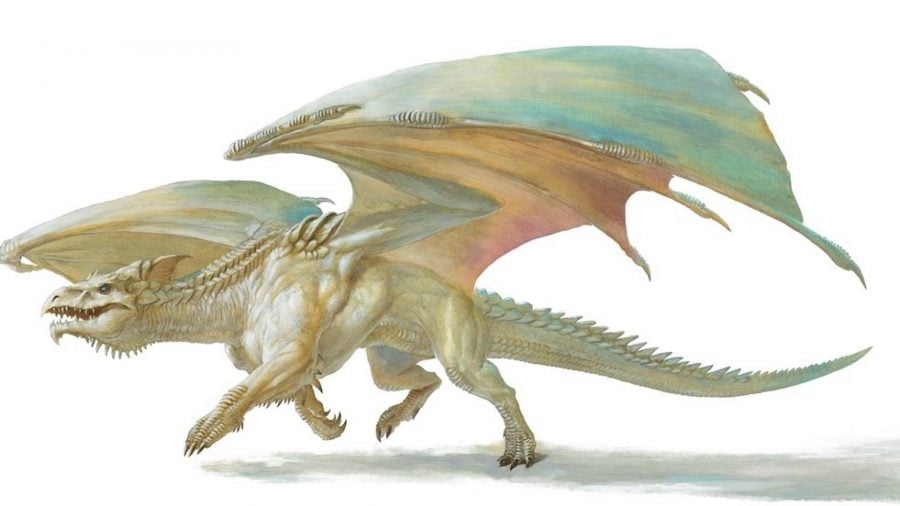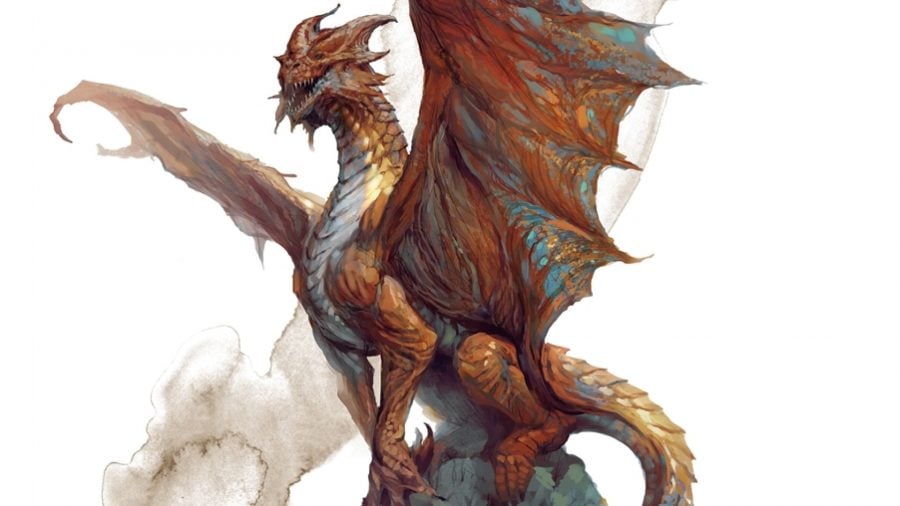A game of Dungeons and Dragons without the dragons is…well, it’s just dungeons. Scaly fiends and friends of all shades colour the planes of D&D, and they can enhance a variety of campaign scenarios. Will players bribe their way out of an evil chromatic dragon’s clutches? Or will they come to the aid of a benevolent metallic dragon?
Besting D&D dragons in combat is a true trial for players – but great risks reap great rewards. Lower-level characters will feel triumph when they dispatch their first wyrmling, and more experienced adventurers get their pick of a treasure trove if they defeat an ancient evil.
But how do you choose the perfect dragon for your campaign? There are a dozen pure dragon species alone – not to mention all the dragon-type monsters players may come across! Sourcebooks like Fizban’s Treasury of Dragons and Monsters of the Multiverse are expanding dragon lore further, making this a trickier choice than ever. We’ve listed some of our top dragon picks below to jumpstart ideas for effective future encounters.
Let’s cut straight to the chase. The ten best dragons in Dungeons and Dragons 5E are:

Dragonborn
When talking about the best dragons in D&D 5E, we had to mention the fact that you can literally be a dragon. Dragonborns are tall, humanoid creatures that display many of the physical features of a dragon – some even have wings or a tail. A dragonborn’s lineage can alter its overall colour. A gem Dragonborn might have sapphire or topaz glinting in its scales, while a chromatic Dragonborn can be a deep shade of black, green, and so on.
In your race: Read our guide to D&D 5E races
Dragon’s blood runs through the veins of the Dragonborn D&D race, and their Breath Weapon means they can spout flames, acid or even lightning thanks to their draconic heritage. Proud and independent, their Charisma and Strength boosts mean that Dragonborns make powerful Paladins, Warlocks or Barbarians.
Dragonborns first graced the pages of D&D in 2006’s Races of the Dragon, but you can find more up-to-date info on them in the following places:

Dracolich
Transformed by powerful necromancy, a dracolich is a decaying, skeletal shell of its former physical self – though certainly no less powerful. Only the most selfish and devious of dragons choose this path, as life after death severs all ties to dragonkind.
When its body is destroyed, a dracolich’s phylactery allows it to return from the dead
Like all liches, a dracolich can store its lifeforce in a phylactery. This means that the dracolich can possess a fresh dragon corpse and rise again should its physical body be destroyed on the same physical plane as the phylactery. A dracolich is able to assail adventurers with bites, wing attacks, and tail attacks – as well as the deadly breath powers it had in life. With a challenge rating of 17, a dracolich can be a challenging foe, even for high-level parties.
Dracoliches first appeared in a 1979 adventure module called White Plume Mountain. Modern stats and rules for this beastie can now be found in the 5E Monster Manual (2014) and Fizban’s Treasury of Dragons (2021).

Dragon Turtle
The gargantuan dragon turtle shares its love of treasure with its cousins above the land. Its perfectly camouflaged shell looks just like light dancing on sea-green waves, so it can ambush ships with surprising stealth despite its size. After using its scalding steam breath, claws, and powerful jaws to bring down a ship, a dragon turtle swallows sinking valuables and transports them to its lair beneath the waves.
Beginner’s luck: Learn how to play Dungeons and Dragons
A dragon turtle has a challenge rating of 17, and a whopping 341 hit points make it a real test of might for adventurers. The silver-tongued in your party may be able to escape the dragon turtle another way, though – it may exchange safe passage for a particularly valuable trinket or bauble.
The first dragon turtle appeared in D&D Volume 2: Monster’s and Treasure (1974), but today’s dragon turtles can be found floating around in the Monster Manual and Fizban’s Treasury of Dragons.

Red Dragon
While many associate the colour green with greed, it’s the red dragon who wears the treasure-hoarding crown. If a party sees smoke billowing from a mountain top, a scarlet-scaled dragon may be defending its treasure trove at the peak. Red is certainly the colour of rage, and a red dragon will burn armies to a crisp on the slightest impulse.
Ancient red dragons have higher stats than other chromatic dragons
Wyrmling red dragons have a challenge rating of four, making them a reasonably tough opponent for a lower-level party. However, an ancient red dragon has the highest strength, constitution, and charisma of any chromatic dragon, and their challenge rating skyrockets from four to 24. Adventurers can expect to have more than just their eyebrows singed.
These classic chromatic dragons were first seen in the original 1974 edition of Dungeons and Dragons. They’re now hiding out in The Monster Manual and, of course, Fizban’s Treasury of Dragons.

Blue Dragon
The blue dragon’s frilled ears and glossy blue scales betray its love of beauty and wealth – with sapphires being a particular favourite. Beware the crackle of static electricity that surrounds them, though, for blue dragons attract thunderstorms and obliterate landscapes with their lightning breath.
They did the mash: It’s our guide to the best monsters in D&D
A challenge rating of 22 may seem unimpressive compared to other ancient chromatic dragons, but blue dragons find cunning ways to use the desert territories that they protect so fiercely. Adventurers approaching a blue dragon’s lair should beware of scattered treasures, as the blue dragon loves to lure thieves into a sinkhole trap.
Blue dragons are also a relic of Dungeons and Dragons 1E, but their stats and rules are now found in the usual 5E places: the Monster Manual and Fizban’s Treasury of Dragons.

White Dragon
The greatest hunters known to dragonkind, white dragons skulk through snow and arctic frost when on the hunt. A party of adventurers is liable to be frozen solid by its ice breath, creating a buffet of humanoid popsicles that make the perfect trophy, or treat, to a white dragon.
White dragon wyrmlings are a balanced challenge for new players
White dragons are the smallest and least intelligent of the chromatic dragons (though we definitely wouldn’t say it to their face). However, lower challenge ratings (starting at 2 for wyrmlings) make white dragons an accessible encounter for those fighting a pure dragon for the first time.
You guessed it – white dragons were also in the first ever Dungeons and Dragons. And yes. they’re also in both the Monster Manual and good old Fizban’s Treasury of Dragons.

Copper Dragon
The copper dragon is a paragon of the term ‘chaotic good’. They’re highly intelligent, sociable and consider a good joke as much of a treasure as gold coins – but be sure to laugh at their jokes if you want to stay in their good books.
You’re in their DMs: Try out this popular D&D starter set
As well as their powerful acid breath, copper dragons also have the power to exhale a gas that, on a failed DC 11 Constitution saving throw, halves the speed of an opponent. Slowed players or monsters will no longer be able to use reactions or take an action and a bonus action on the same turn.
Copper dragons were first introduced in Greyhawk, a 1975 supplementary rulebook to the first D&D system. However, they’ve caught up with their chromatic counterparts now, and their stats and rules are easily found in the Monster Manual and Fizban’s trusty Treasury.

Gold Dragon
Gold dragons really are the gold standard when it comes to doing good in the world. Aloof and private, older gold dragons have even developed the ability to disguise themselves as humanoids and animals – though their preference for eating gold, pearls and gems will be a dead giveaway.
Gold dragons have the powers of disguise, fire, and weakening breath that gives a strength disadvantage
Out of all metallic dragons, gold dragons have the highest (or joint-highest) core stats in almost every category – beaten only in intelligence by the copper dragon. An ancient gold dragon’s fire breath deals 71 damage to anyone unlucky enough to fail a DC 24 Dexterity saving throw, and their weakening breath gives players disadvantage on Strength-based attack rolls, strength checks and strength saving throws for 1 minute on a failed DC 24 Strength saving throw.
Unlike many of their metallic cousins, gold dragons were actually part of the original Dungeons and Dragons rulebook. No surprises for where you’ll find the best resources on them now – that’s it: Monster Manual; Fizban’s Treasury of Dragons. Classic dragons officially sorted.

Tiamat, the Dragon Queen
She goes by many names: The Chromatic Dragon, Queen of Chaos, Nemesis of the Gods. No list of D&D dragons would be complete without Tiamat, the evil goddess that rules over chromatic dragonkind. She is distinguished by her five independently-moving heads. Each has the colour and powers of one of the five chromatic dragons: blue, red, green, white, and black. With a challenge rating of 30, many players are better off encountering Tiamat in stories rather than in battle.
School’s out: Take the guide to D&D classes for a test spin
Tiamat’s name first graced the D&D page in Greyhawk. Fizban’s Treasury of Dragons provides the stat block for the Aspect of Tiamat, a version of herself Tiamat can send to manifest in the material plane. If you want to see Tiamat at her full power, you may want to check out the stat blocks in the Tyranny of Dragons adventure titles: Hoard of the Dragon Queen (2014) and Rise of Tiamat (2014).

Bahamut, the Platinum Dragon
Fortunately for many, Tiamat has a counterpart that fights for good: her brother Bahamut. This metallic dragon deity is often referred to as the grandfather of dragons, and he is said to be the only platinum dragon in existence. Bahamut has scales tougher than any shields, but he is known to shapeshift into a human form that lets him wander the world.
Bahamut’s roar can deafen foes – or turn them to into dust
Bahamut famously avoids combat and killing. However, with a challenge rating of 30 – to match his sister’s – he’s no pushover. Bahamut’s breath can freeze enemies or turn them into gas, and his legendary roar has the power to deafen – or even disintegrate – any who stand in his way.
Not one to be left out, Bahamut was also a Greyhawk addition. DMs should be aware that the 5E stats for Bahamut come from the Aspect of Bahamut found in Fizban’s Treasury, as he can join the material plane much like his sister. A stat block for Bahamut in his complete form is included in ‘Draconomicon: Metallic Dragons’ (2009) from D&D 4E if any keen homebrewers are looking for inspiration.
Source: Wargamer




